 Are you struggling to remain visible in Facebook's news feed?
Are you struggling to remain visible in Facebook's news feed?
Wondering how Facebook decides what to show in the news feed?
In this article you'll discover how the Facebook news feed algorithm works, what's been updated, and how marketers can respond to create more visibility on Facebook.
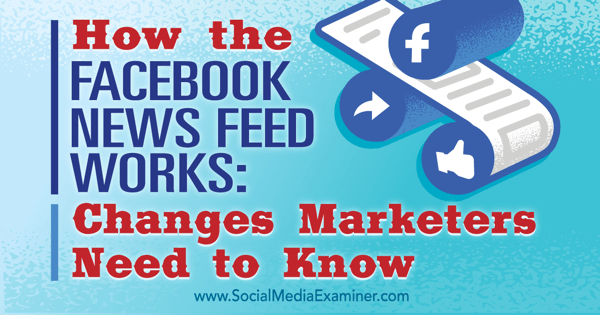
Listen to this article:
Where to subscribe: Apple Podcasts | Spotify | YouTube Music | YouTube | Amazon Music | RSS
#1: Facebook Prioritizes Content Topics in the News Feed Based on the Time a User Spends on Similar Content
Previously, Facebook said it wouldn't give higher organic reach to instant articles in the news feed. However, that didn't mean instant articles would not be part of its algorithm to determine what posts should get more organic reach in the news feed.
According to Facebook's first post on the change, Facebook will now use time spent reading or watching content as a signal that a particular story was important to the user. Content includes video, instant articles, and articles loaded in the mobile browser from the Facebook app. The time spent viewing signal will be used to predict what other content users might find interesting, and will show users similar content in their news feed.
Here's how you can use time spent viewing to your advantage:
If you want more people to see your content in the news feed, make sure that people stick around long enough to consume your content. Whether it's video, instant articles, or content that people load in the mobile browser from the Facebook app, the key is to create content that keeps people engaged.
You can do this a couple of different ways. For starters, be sure that your content delivers what the headline promises. You need to craft a headline that's irresistible enough to click, and include a video or article introduction to show you'll deliver on that headline.
You can create longer videos and articles; however, not too long. Facebook looks at the time spent on a piece of content within a maximum threshold.
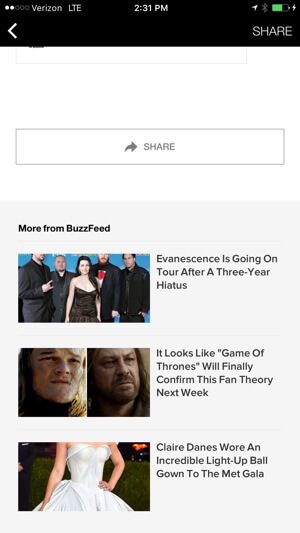
The goal is to make sure that people don't click through to your content and immediately click away from it.
#2: Facebook Plans to Add Diversity to News Feed Sources
While researching its Feed Quality program, Facebook learned that users want to see wide-ranging content from different publishers, as opposed to back-to-back articles from the same source. Hence, Facebook will reduce how often users see several posts in a row from the same source in their news feed.
Here's how you can use diversity to your advantage:
This is a tricky one, especially for content publishers that publish 5+ posts per day. Authors who write on a variety of publications are the real winners. Essentially, those authors could end up being seen in the news feed multiple times per day because their content would come from different sources.
Get World-Class Marketing Training — All Year Long!
Are you facing doubt, uncertainty, or overwhelm? The Social Media Marketing Society can help.
Each month, you’ll receive training from trusted marketing experts, covering everything from AI to organic social marketing. When you join, you’ll also get immediate access to:
- A library of 100+ marketing trainings
- A community of like-minded marketers
- Monthly online community meetups
- Relevant news and trends updates
Businesses using quality guest blogging as a tactic for gaining exposure in their industry should consider spreading content to multiple sites for better organic exposure in the Facebook news feed.
Another way to be more diverse and still appear multiple times in the news feed is to repurpose content.

Effectively, you could share multiple pieces of content per day from different sources (your blog, your Medium blog, Facebook notes, your LinkedIn Publisher blog, etc.), along with different Facebook accounts (your page, employee profiles with public followers, your groups, etc.).
#3: Facebook Wants to Connect Users With the Stories That Matter Most to Them
Facebook's second post about the news feed algorithm updates was a video from the F8 conference about how the news feed works with Adam Mosseri, VP of product management for news feed. He states that Facebook's mission is to connect users with the stories that matter most to them.
Here's how you can use Facebook's news feed mission to your advantage:
Ultimately, Facebook's news feed mission should also be your mission each time you create content, whether it's on Facebook, your blog, or any other social network. You should strive to create stories that matter to your target audience.
#4: Facebook Builds Users' News Feeds Based on the Friends They Connect With and Publishers They Follow
As you connect with more people and like more pages that publish content, your news feed evolves to show you posts from those people and from those pages. Further, the groups a user joins also play a role in what news feed content a user sees.
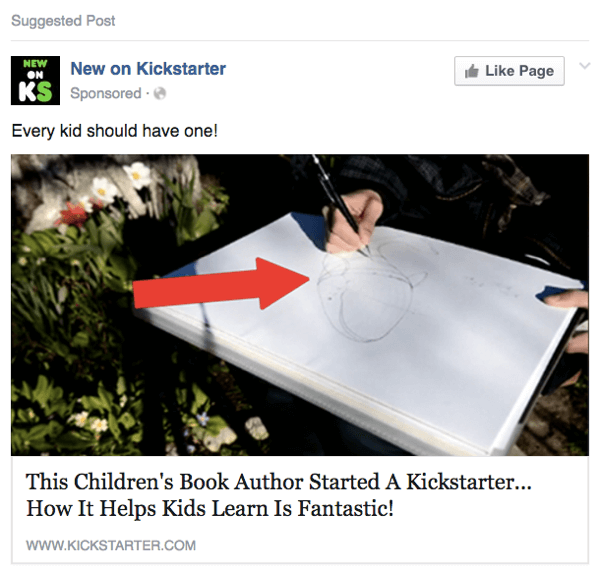
Here's how you can use a person's choice of friends and publishers to your advantage:
How could you, as a business, build a user's news feed with friends, pages, and groups to help boost your chances of getting better organic reach? Simple. Start by finding out who loves your brand, your products, your services, and your content. Then, identify and recommend those people to others.
Identify the people who allow followers on their profiles, particularly those who talk about you or share your content. Recommend that people follow them. Make that person your featured fan of the week or the month. The individual will be happy to get new followers, and you'll be happy the next time he or she mentions you or shares your content because all of those new followers may see it.
Identify the individuals and businesses with pages who talk about you or share your content. Recommend that people like them. Highlight them as someone whose product or service you use or respect, or simply great pages to follow. The individuals or businesses will be happy to get new fans, and it will benefit you when they mention you or share your content because all of their new fans may see it.

Discover Proven Marketing Strategies and Tips
Want to go even deeper with your marketing? Check out the Social Media Marketing Podcast! Publishing weekly since 2012, the Social Media Marketing Podcast helps you navigate the constantly changing marketing jungle, with expert interviews from marketing pros.
But don’t let the name fool you. This show is about a lot more than just social media marketing. With over 600 episodes and millions of downloads each year, this show has been a trusted source for marketers for well over a decade.

Identify the groups that talk about you or share your content. Recommend that people join them. Share the fact that this is a quality group where your audience will find people discussing the topics that interest them. Once again, the group gets new members, and you get extra exposure when the group mentions you or shares your content.
#5: Facebook Looks at the Type of Content in a Post and Whether a User Likes That Type of Content
Facebook takes several factors into account when deciding the priority in which to place a post in a user's news feed. One factor is the type of content shared: text, photo, video, or a link. If users typically engage with photos more than videos, they'll likely be shown more photos than videos.
Here's how you can use content types to your advantage:
This one is simple. While most statistics will tell you that video has the highest organic reach, remember that not everyone likes video. So diversify your content. If you've got the time to publish four updates a day, post one text-only update, one photo update, one video update (directly uploaded to Facebook), and one link update. This will ensure that you've created at least one post with a content type that appeals to all of your fans.
#6: Engagement Can Beat Recency
Additional factors that Facebook takes into account when deciding a post's priority in a user's news feed is engagement and recency. If you haven't posted anything in weeks, chances are nothing from you is going to show up in someone's news feed if they follow other people.
On the other hand, if you posted something this morning, and yesterday someone else posted something that has more engagement (reactions, comments, and shares), chances are the user will see the post with more interactions first, even though your post is more recent.

Here's how you can use recency and interactions to your advantage:
Recency and interactions go hand in hand. Make sure you post often so you always have posts for Facebook to consider showing to your fans. You also want to make sure that your posts are getting engagement.
If you publish several posts a day, but there's always that one post you want to make sure everyone sees, make sure you give your most important post an extra bump. That bump could be through Facebook advertising or simply sharing a direct link to the Facebook post (using the post's timestamp) to your other social media audiences.
#7: Facebook Offers Users Control Over Their News Feed
Ultimately, Facebook offers users control over their news feed. Users can unfollow people whom they want to stay friends with, but not see their posts. They can hide specific posts so they see fewer similar posts. They can ask to see posts from specific profiles or pages first in their news feed, regardless of what they are.
Here's how you can use controls to your advantage:
Assume that the average user doesn't know that these controls exist. Get a screenshot of your Facebook page to show your fans how they can activate the option to see your Facebook page posts first in their news feed. Make this screenshot a pinned post at the top of your timeline, or possibly make it a small portion of your cover photo!
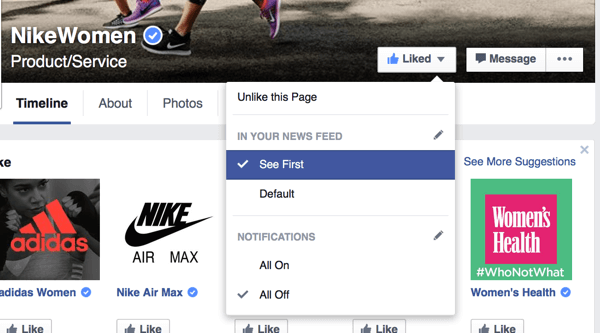
Encouraging your fans to do this with your Facebook page will allow them to create news feeds that they enjoy coming to every day.
The See First feature is available for Facebook profiles, too, so that's something to keep in mind if you have your personal profile open to followers for public updates.
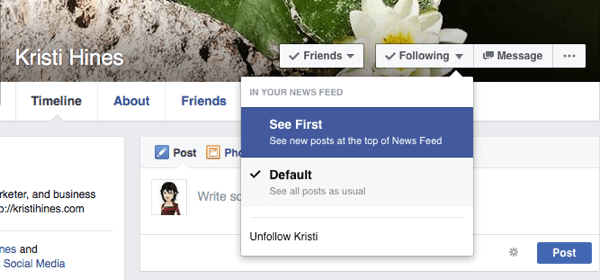
Additional Facebook Tips
In addition to the information about the changes in the Facebook news feed algorithm, Adam Mosseri also offered these tips for Facebook publishers:
Write compelling headlines, not clickbait headlines that disappoint. Try to write headlines that actually let the user know what to expect from the content they're about to click on.
Avoid overly promotional content that will ultimately turn users off of clicking through to your future content.
Experiment. What's best for one audience is not best for another. Try short form, long form, video, and different tones. Then use Publisher Tools to see what works.
If available, use Audience Optimization. It will allow you to specify audiences that will be interested in your content. Facebook will use it as part of the ranking in particular users' news feeds.
Follow the Facebook Media Blog for tips on how publishers in specific industries can get more out of their Facebook experience. And don't forget to follow the News Feed FYI to learn more about changes to the Facebook news feed algorithm.
Conclusion
Ultimately, the struggle for organic reach on Facebook is still real for Facebook page owners. Hopefully, knowing more about how the Facebook news feed algorithm works will help you find more ways to reach your audience, either directly from your Facebook page or through others' profiles, pages, and groups on Facebook.
What do you think? What changes do you plan on making to your Facebook marketing strategy? Let us know in the comments!
Repurpose content photo from Shutterstock.
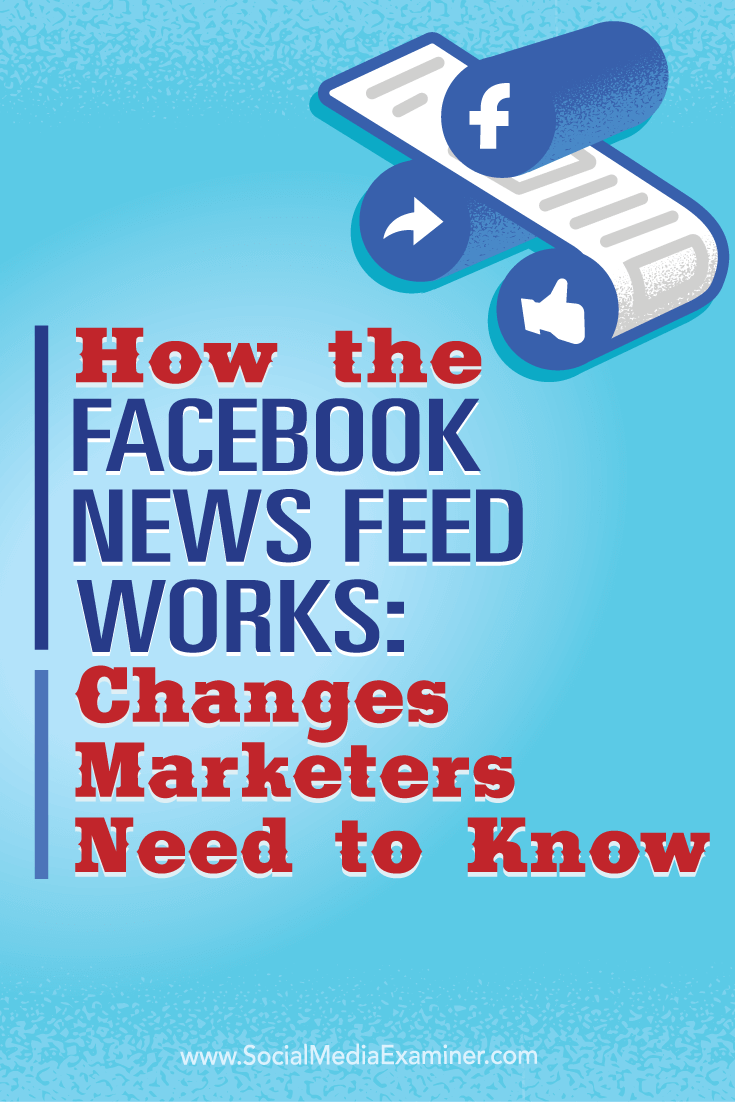
Attention Agency Owners, Brand Marketers, and Consultants

Introducing the Marketing Agency Show–our newest podcast designed to explore the struggles of agency marketers.
Join show host and agency owner, Brooke Sellas, as she interviews agency marketers and digs deep into their biggest challenges. Explore topics like navigating rough economic times, leveraging AI, service diversification, client acquisition, and much more.
Just pull up your favorite podcast app, search for Marketing Agency Show and start listening. Or click the button below for more information.

